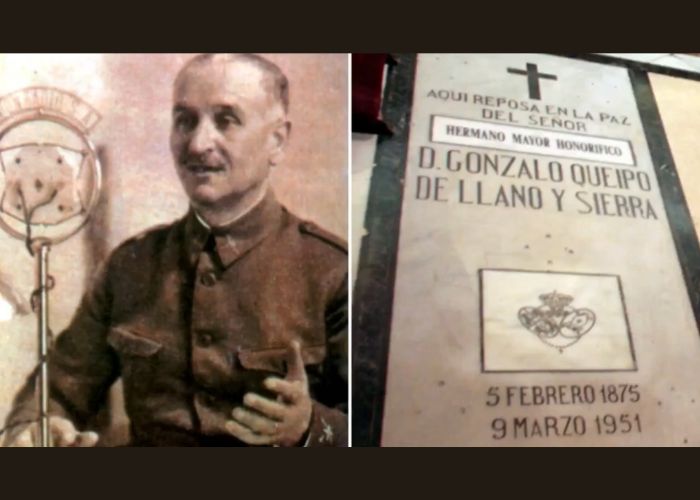SEVILLE – The remains of the Francoist general Queipo de Llano will be exhumed in November from the Basilica La Macarena in Seville and replaced to another place. The dig complies with the new Democratic Remembrance Act.
This 2007 Spanish law, which aims to compensate victims of the Spanish Civil War (1936-1939) and the subsequent dictatorship of Francisco Franco (1939-1975), was recently amended. The most important change is that “the coup of 1936 and the ensuing Civil War and dictatorship are openly rejected and glorification is punished”.
Gonzalo Queipo de Llano (February 5, 1875 – March 9, 1951) was the general who led the 1936 coup. Furthermore, he was responsible for 45,000 deaths in Andalucia. He is buried in the basilica along with Francisco Bohórquez Vecina, whose remains are also being removed. Bohórquez Vecina was the executor of tens of thousands of executions in Seville under Franco’s rule. Queipo de Llano ordered the construction of the basilica after the Civil War and was therefore named Honorary Brethren (Hermano Mayor Honorario) of this brotherhood that was founded as early as 1535.
Excavation “as soon as possible”
The brotherhood of Macarena, the largest in Spain with 15,600 members, said in response to a letter from the Sánchez government last week that the remains will be exhumed and moved in November. That letter from the State Secretary for Democratic Memory demanded that the excavation be carried out “as soon as possible”.
It is not the first time that the presence of these remains in Seville has violated a legal regulation. An Andalucian law of democratic memory already exists. This also made it clear that it is illegal to keep these tombs in a prominent place in the temple.
No priority
Queipo de Llano and Bohórquez Vecina’s exhumation requests had already reached the basilica. But so far this has not been given priority. Moreover, neither the Andalucian government of socialist Susana Díaz, nor that of her successor, Juanma Moreno, took any steps to demand that the Brotherhood of Macarena exhume those remains. Both hide behind the fact that the regulation, which is supposed to supplement the legal standard and allow precise instructions, had not yet been approved. The Brotherhood indicated each time that it was waiting for guidelines in order to act. Last Monday, however, the Brotherhood of La Macarena announced that it would continue the excavation to comply with the law. And, furthermore, stated that it had already begun procedures to do so.
Tombstones changed
The tombstones in the basilica in Seville commemorating the presence of Queipo de Llano and his wife have previously been modified to conform to successive laws of memory. In 2009, all Franco symbols were removed and the emblem of the Gran Cruz Laureada de San Fernando with which the general had been awarded by Franco. And the text “the most excellent sir lieutenant general”, was replaced by “honorary brethren”. This was to emphasise his relationship with the brotherhood rather than his prominent role in the dictatorship, oppression and execution of thousands of civilians .
Excavation of Francisco Franco
The excavation of the remains of the dictator Francisco Franco from the Valley of the Fallen on October 24, 2019 revived the controversy over the presence of Queipo de Llano in the basilica of La Macarena. According to El Diario de Sevilla, the remains of the general in Seville were not excavated at the time due to a legal vacuum. Different laws applied to each situation. While the Valle de los Caídos – renamed Valle de los Cuelgamuros since the new Democratic Memory Act – is state property, the Macarena Basilica is privately owned by the Brotherhood.
Gonzalo Queipo de Llano
British historian Paul Preston in his latest work refers to Queipo de Llano as the psychopath of the south. As chief of the army in southern Spain, he was directly responsible for the deaths of more than 45,000 people. 14,000 of which were in Seville, where there were almost no battles. Among them, the poet Federico García Lorca and the politician Blas Infante, institutionally recognised as the father of the Andalucian homeland. He left more than 700 mass graves, some so large that they are estimated to contain more than 1,300 victims of Franco’s repression.


